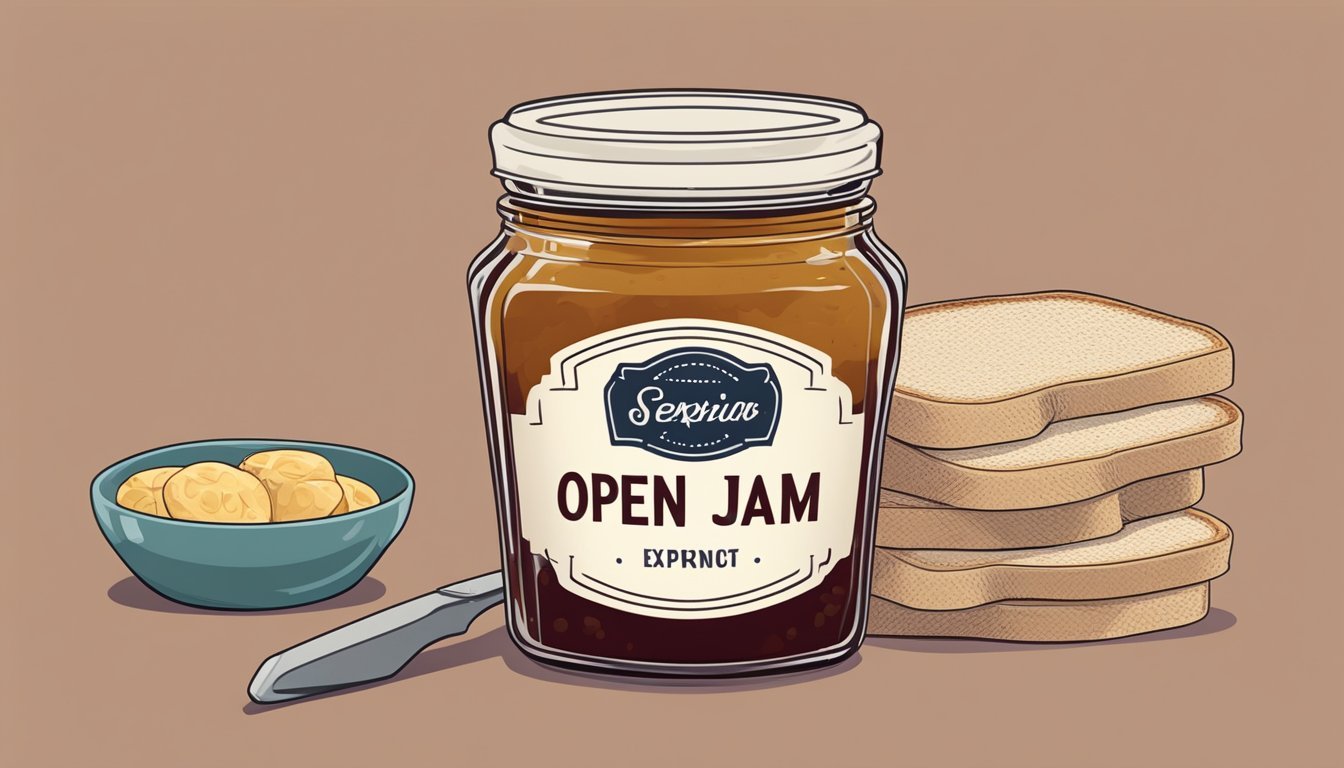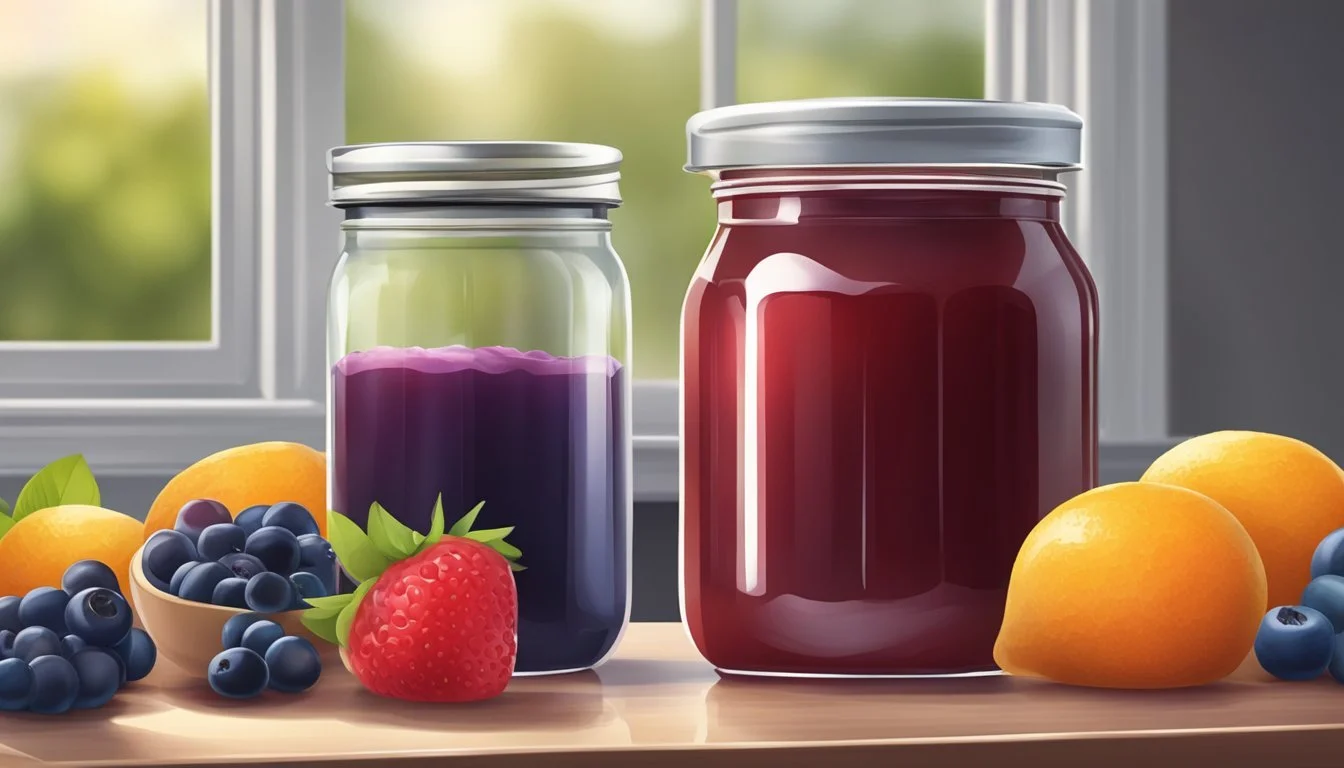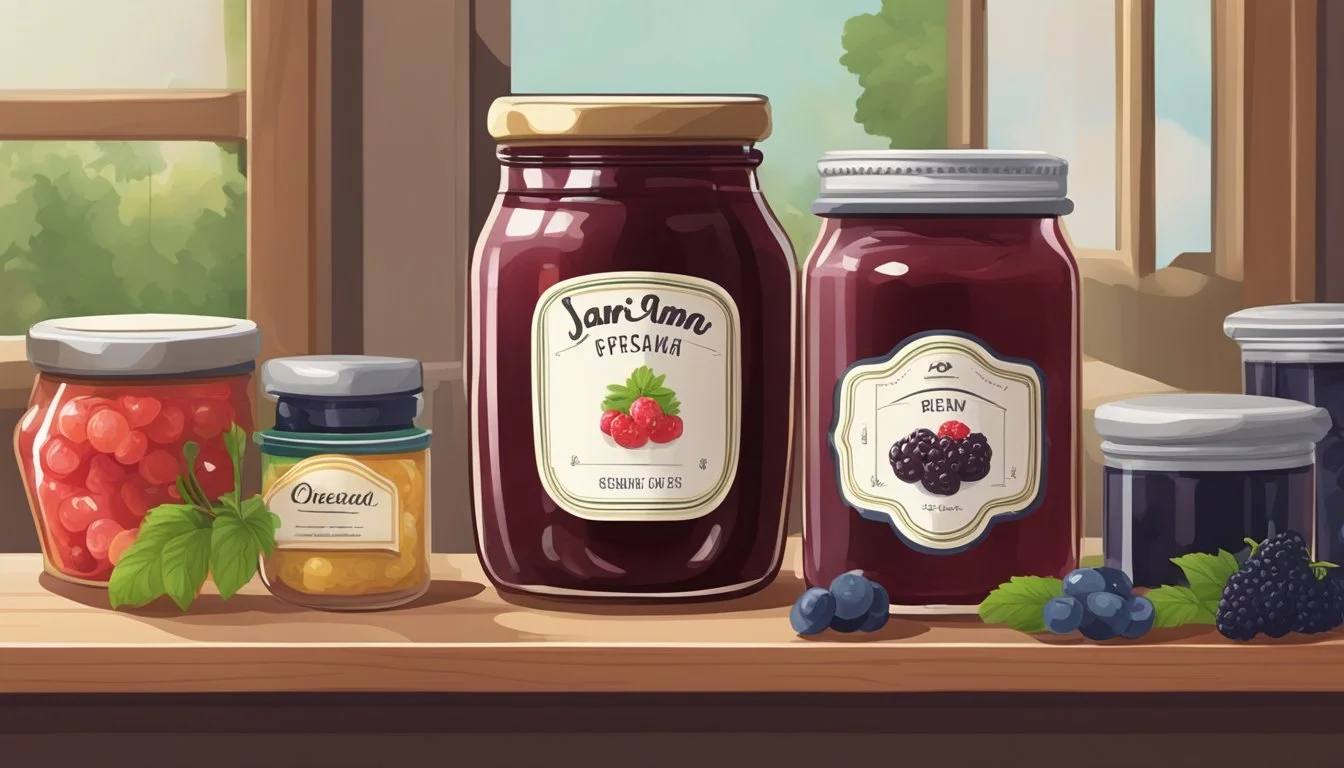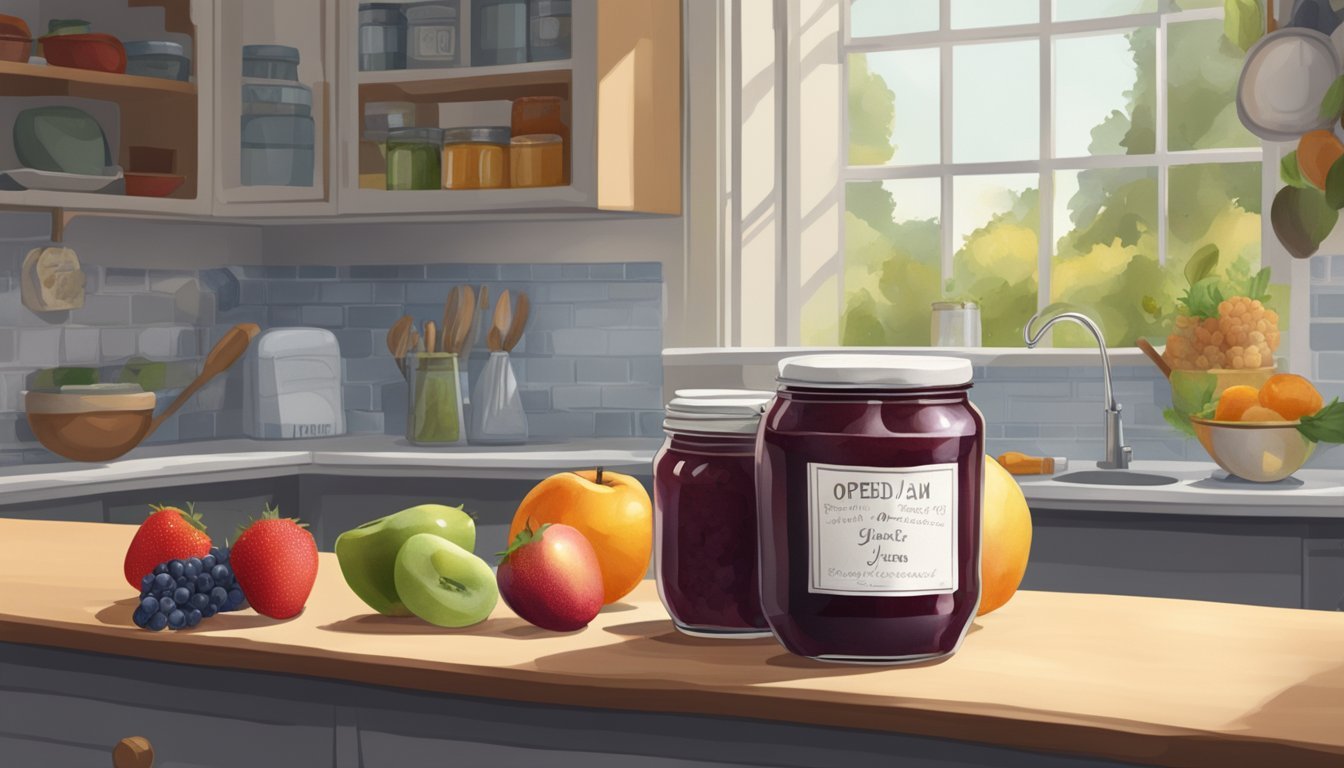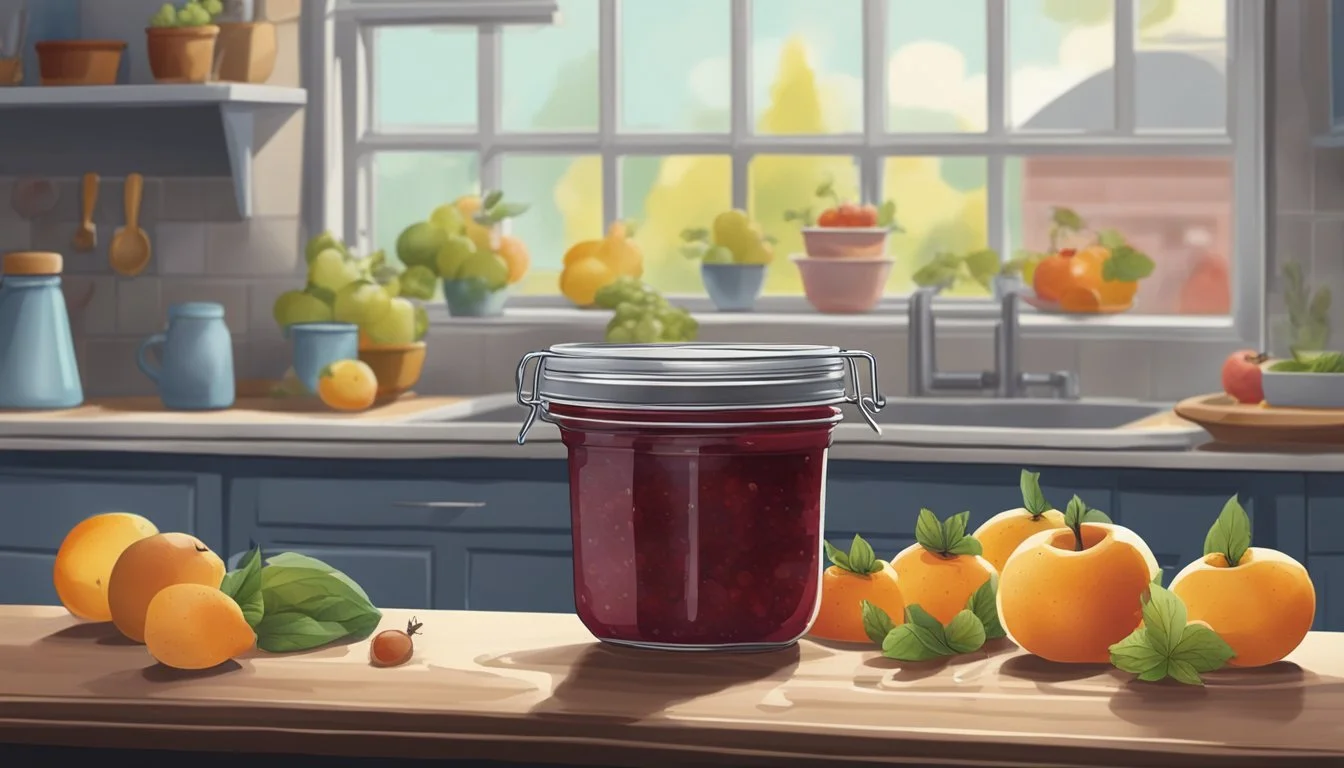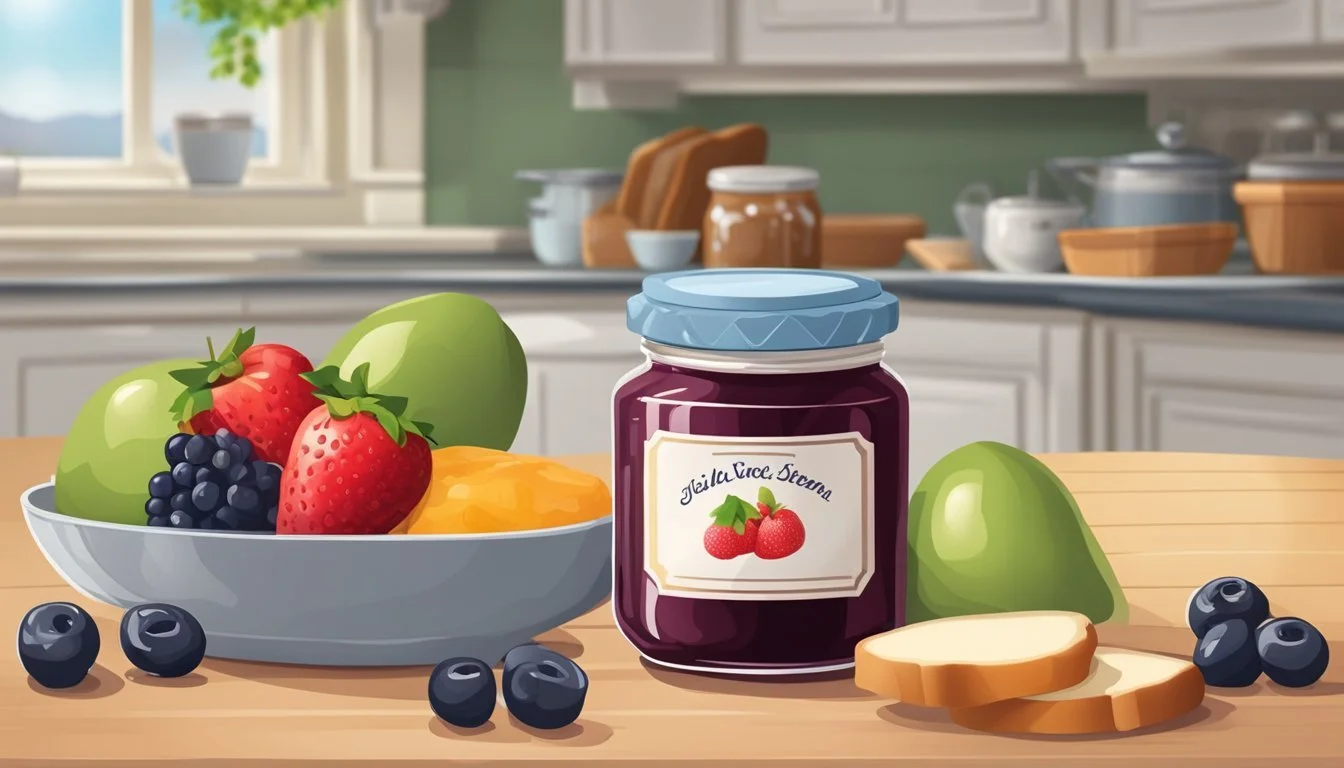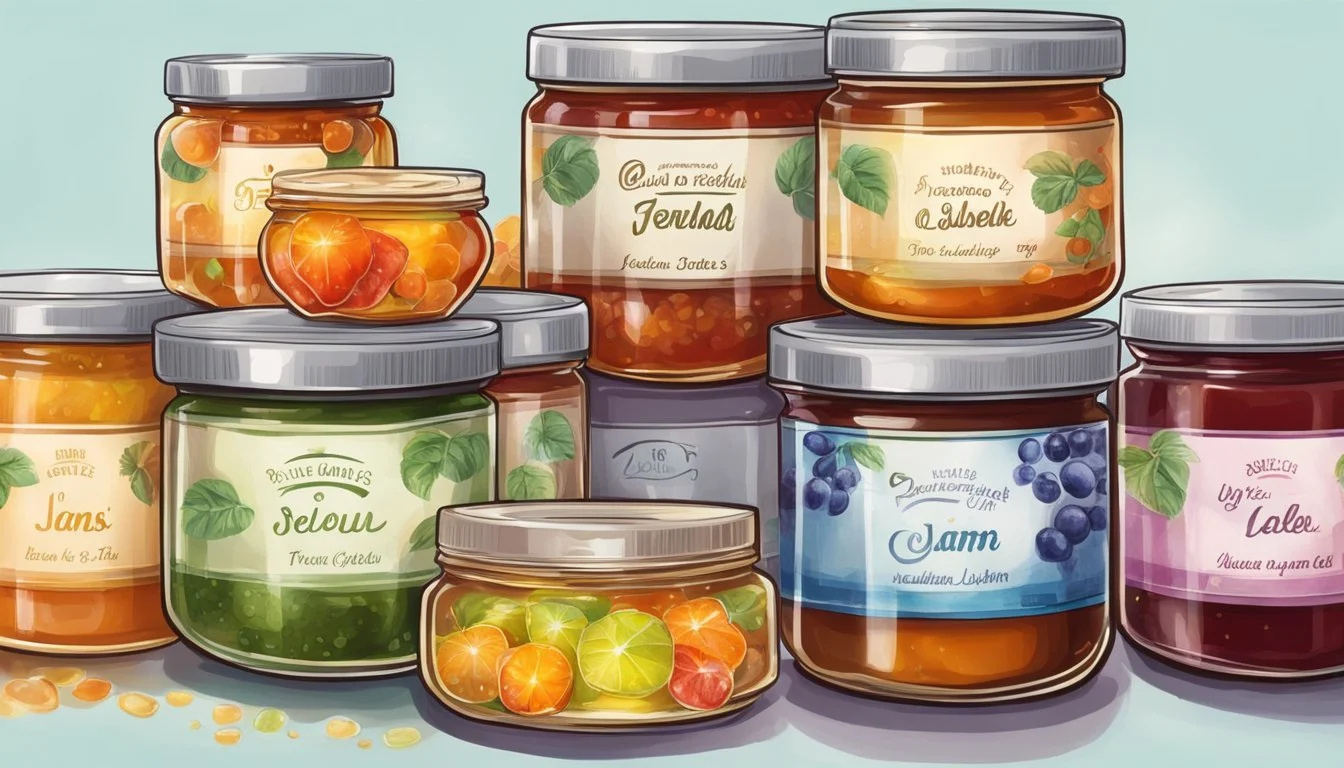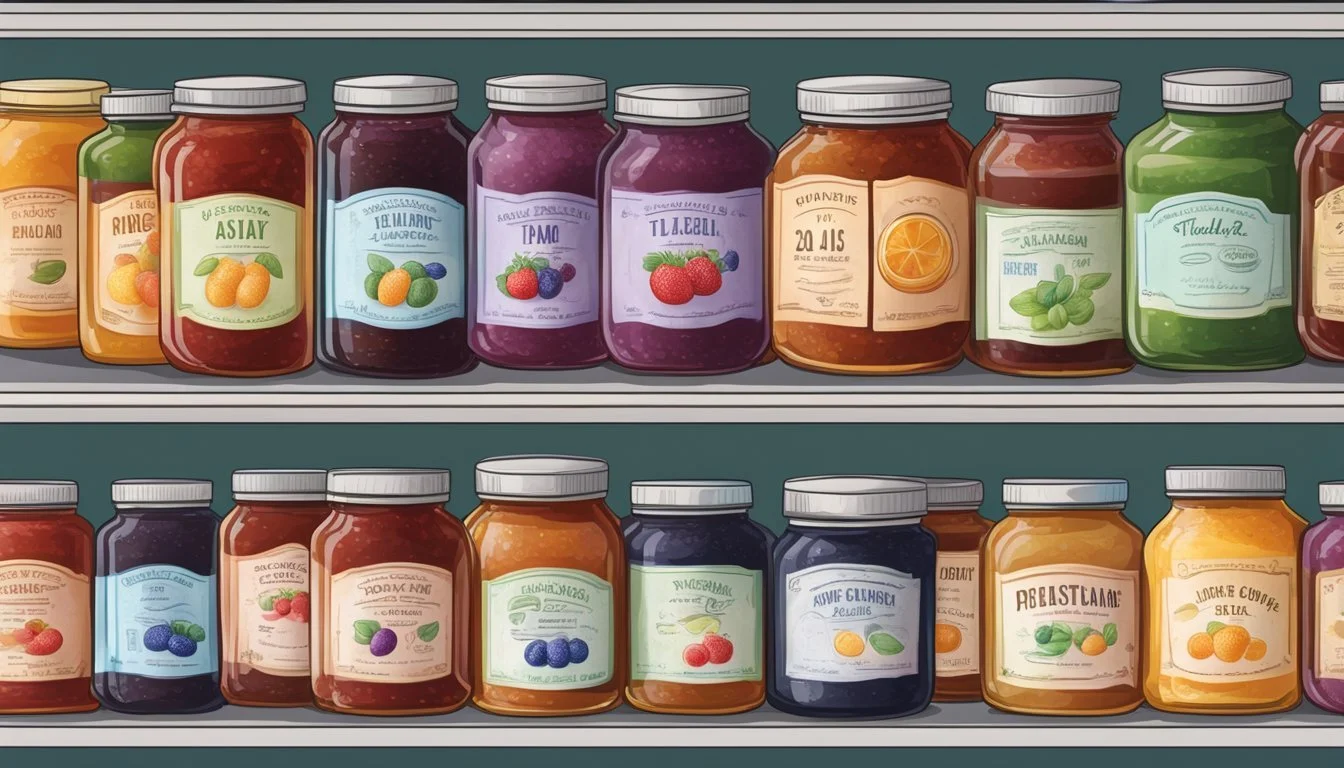How Long Do Freshly Prepared Jams and Jellies Last After Opening?
Shelf Life Explained
Preserving the flavors of the season, freshly prepared jams and jellies offer a delightful blend of fruit and sweetness, capturing the essence of various fruits at their peak. However, once the seal of a jar is broken, the longevity of these spreads becomes a topic of vital interest, especially for those who value homemade preserves. Typically, an opened jar of homemade jam or jelly should be kept in the refrigerator, where it can maintain its quality.
Upon opening, the shelf life of these spreads is influenced by several factors including their sugar content, the presence of preservatives, and the method of preparation. Generally, an opened jar of jam or jelly will last about one to three months in the refrigerator. Jams, due to their chunkier texture and less rigid set, may deteriorate in quality faster than jellies, which have a more gel-like consistency.
It's important to store these spreads properly, ensuring they're kept at 40°F or lower to prevent the growth of mold and spoilage. The use of proper sterilization techniques during the canning process can extend their shelf life, whereas quick jams or freezer jams, which skip canning, have a reduced refrigerator life of up to 10 days and should be consumed more promptly to enjoy their freshness.
Basics of Jam and Jelly Preservation
Preservation of jams and jellies hinges on the balance of preservatives, sugar, and acid levels to ensure a stable and safe product. Properly utilized, these factors inhibit bacterial growth and maintain quality.
Understanding Preservatives
Preservatives play a crucial role in extending the shelf life of jams and jellies. In homemade preserves, natural preservatives like sugar and acid are pivotal components that act as hurdles against spoilage. For commercial products, additional preservatives may be included to prolong freshness. When a jam or jelly is opened, its shelf life is influenced by the concentration of such preservatives as well as how the product is stored.
Role of Sugar and Acid
Sugar's role in jam and jelly preservation is multifaceted; it acts as a preservative, contributes to flavor, and affects the gelation process. The sugar in preserves draws out water from the fruit, which helps to inhibit microbial growth. Sugar's protective effect is proportional; higher levels equate to better preservation. Simultaneously, acid is necessary not only for the set of the jelly or jam, where it reacts with pectin, but also for preventing the growth of harmful pathogens. Ideally, jams and jellies should be stored in the refrigerator at low temperatures to maintain these conditions and keep the products safe for consumption after opening.
Storing Jams and Jellies
Proper storage of jams and jellies is crucial to maintain their quality and extend their shelf life once opened. The recommended storage methods vary between refrigeration and dark, cool pantry spaces.
Refrigerator Storage
Jams and jellies should always be refrigerated after opening to prevent spoilage. When refrigerated at 40°F (4°C) or lower, opened jams and jellies typically have a shelf life of 1 to 3 months. Full-sugar, pectin-added jams and jellies may last up to 1 month, depending on the product. Freezer or quick jams, which skip the canning process, can last up to 10 days if refrigerated.
Recommendation:
Refrigerate opened jams and jellies immediately.
Consume within 1 to 3 months for best quality.
Tips:
Always use a clean spoon to avoid introducing contaminants.
Check for signs of mold or an off-smell before use.
Pantry and Dark Place Options
Unopened jams and jellies can be stored in a pantry or a dark place at room temperature until the expiration date, as long as the space is cool and away from direct sunlight. Opened jams and jellies may be kept in a cool, dark place for a very short period, not exceeding one week, although this is less ideal than refrigeration due to increased risk of spoilage.
Recommendation:
Store unopened jars in a cool, dark pantry to maintain shelf life.
Once opened, aim to transfer to the refrigerator for longer-term storage.
Tips:
Be cautious and check for spoilage if kept in pantry after opening.
A consistent, cool temperature helps to maintain the product quality.
Factors Affecting Freshness
Maintaining the freshness of opened jams and jellies is critical to preservation and safety. Storage conditions largely dictate their shelf life, and it's important to monitor factors such as temperature, humidity, and the presence of microorganisms.
Temperature and Humidity Influence
Temperature and humidity play significant roles in the preservation of jams and jellies. Once opened, these products should be kept in a refrigerator at temperatures between 32°F and 40°F (0°C to 4°C) to slow down the spoilage process. Excess humidity, on the other hand, can introduce unwanted moisture into the product, creating an environment conducive to mold growth and spoilage.
Microorganisms and Mold Growth
Microorganisms, such as bacteria and molds, are the primary culprits in spoilage. They thrive in warmer, moist environments. Once a jar is opened, airborne spores may contaminate the product, and due to the presence of sugar in jams and jellies, molds can quickly establish themselves. For this reason, sealing the jar tightly after each use is essential to minimize the exposure to these microorganisms.
Determining Shelf Life
The shelf life of opened jams and jellies is influenced by whether they are commercially produced or homemade, and understanding the expiration dates can help consumers enjoy these products at their best quality.
Commercial vs. Homemade
Commercially produced jams and jellies typically come with a best by or use by date on their labels, providing a manufacturer's estimate for peak quality. Once opened, these products generally maintain their freshness for up to 1 to 3 months when stored in a refrigerator.
In contrast, homemade jams and jellies lack a printed expiration date, but they often last approximately 1 month in the fridge once opened. The exact time may vary based on ingredients, storage conditions, and preparation methods. Proper canning techniques extend the shelf life of homemade varieties, with unopened homemade preserves having the potential to last up to 2 years when stored in a cool, dark place.
Estimating Expiration
To best estimate the expiration of an opened jar of jam or jelly, consumers should consider:
Visual and olfactory indicators: Any signs of mold or off-odors are clear indicators that the product should no longer be consumed.
Storage conditions: Refrigeration at 40°F or lower is essential to slow microbial growth and preserve quality.
Texture changes: Jellies should remain firm, while jams should maintain their characteristic spreadability without excess liquid separation.
For homemade jams and jellies, marking the jar with the date they were made can help track how long they have been in use. Consumers should consume them within 1 month for optimal taste and safety.
Signs of Spoilage
When assessing whether jams and jellies have gone bad, one must observe certain signs of spoilage. These signs are key to ensuring that the product is still safe to consume.
Visual Clues
Visual inspection is crucial in identifying spoiled jams and jellies. One should look for:
Mold Growth: The presence of mold, which can appear as fuzzy spots of green, blue, white, or black, is a clear indicator that the jam or jelly should not be consumed.
Color Changes: If the color has changed significantly from when the product was first opened, this can signal spoilage.
Consistency: An unusually watery or thickened texture, separate from the natural setting process of jams and jellies, can suggest decay.
Olfactory Indicators
Smell is a powerful tool in detecting spoilage:
Odor: A sour or off-smelling aroma is a strong indicator that the jam or jelly has begun to ferment or spoil.
Fermenting: Any sign of bubbles or a yeasty smell may indicate that fermentation has occurred, signifying spoilage and that the product is no longer safe for consumption.
These signs are important for determining the freshness and safety of jams and jellies, and they should be taken seriously to avoid the consumption of spoiled food.
Safety Practices in Preparation
Ensuring safety during the preparation of jams and jellies is crucial for long-term preservation and to prevent foodborne illnesses. Adherence to proper canning methods and meticulous prevention of cross-contamination are fundamental.
Proper Canning Methods
The integrity of fresh jams and jellies largely depends on the canning process. Boiling water bath canning is the recommended method for high-acid foods like fruits which are commonly used in jams and jellies. Glass canning jars should be used and must be free from any chips or cracks. These jars must be sterilized in boiling water for at least 10 minutes prior to use.
The following steps should be followed for water bath canning:
Fill canning jars with hot jam or jelly, leaving a quarter-inch of headspace as this allows for the expansion of the contents during the boiling process.
After filling, wipe the rim of the jar with a clean paper towel to ensure a good seal.
Place lids on jars and secure the bands, ensuring they are hand-tight.
Place jars in the canner, and make sure they are completely submerged in water.
Boil for the recommended time based on the recipe used and altitude considerations.
For low-acid foods, pressure canning is essential to eliminate the risk of botulism by reaching temperatures higher than that of boiling water.
Preventing Cross-Contamination
To inhibit the growth of bacteria and prevent cross-contamination, a high level of cleanliness is crucial. All equipment, surfaces, and hands must be thoroughly washed before starting the canning process. It is imperative to use only clean utensils when handling the jam or jelly, especially after the jar has been opened.
Key practices include:
Sterile equipment: All tools, from ladles to funnels, should be sterilized or cleaned properly.
Separation: Avoid using the same cloths and utensils with different food items without cleaning in between uses.
After opening: Once a jar of jam or jelly has been opened, a clean spoon should be used with each serving to maintain the freshness and extend shelf-life.
Advanced Preservation Techniques
When preserving homemade jams and jellies, certain methods can extend the shelf life and maintain the quality once opened. Two such techniques involve reducing sugar content or incorporating alcohol as a natural preservative.
Low Sugar and Sugar-Free Options
Jams and jellies traditionally rely on sugar for preservation. However, one can opt for low sugar or sugar-free alternatives that require specific preservatives to ensure longevity. More information on these low-sugar methods can often be found in sources such as the National Center for Home Food Preservation.
Low Sugar Options: Pectin products specifically formulated for low sugar recipes can help achieve the desired consistency and extend shelf life.
Sugar-Free Alternatives: Artificial sweeteners can be used, although they do not preserve as sugar does. Thus, a preservative that does not rely on high sugar content, such as lemon juice or citric acid, may be needed for adequate food safety.
Using Alcohol for Preservation
Alcohol can act as an effective preservative for homemade jams and jellies, elevating both the complexity of flavors and the longevity of the preserve.
Types of Alcohol: Spirits such as brandy, rum, or bourbon are popular choices.
Method: Incorporating a small amount of alcohol into the jam or jelly at the end of the cooking process ensures that some of the alcohol evaporates while enough remains to preserve.
Storage Tip: Despite these advanced techniques, always refrigerate opened jams and jellies to maintain their best quality.
Handling and Usage Tips
Proper handling and storage of opened jams and jellies are crucial for maintaining their quality and safety. These tips aim to provide specific and practical advice on how to ensure one's preserves remain delicious and safe for consumption after opening.
After Opening Best Practices
Once opened, it's essential to seal the jam or jelly container tightly after each use. The introduction of air can spur the growth of mold and bacteria. Therefore, immediately returning the product to the refrigerator after use helps prevent spoilage. Using clean utensils each time one scoops out the jam or jelly is also vital; this avoids cross-contamination, which can accelerate spoilage.
Maximizing Longevity
To extend the shelf life of opened jams and jellies, they should be kept refrigerated at 40°F or lower. Refrigeration slows down the growth of microorganisms and preserves the taste and quality. For jams and jellies containing acidic ingredients like lemon or vinegar, these can act as natural preservatives that may slightly enhance longevity. However, they should still be consumed within the recommended time frame:
Refrigerated Jam: 1 to 3 months
Refrigerated Jelly: Up to 6 months
Following these specific guidelines will help ensure that one's preserves stay safe to eat and as flavorful as possible for the duration of their post-opening shelf life.
Alternative Homemade Preserves
When discussing the longevity of opened homemade preserves, it's important to consider the variety of preserves available. Different types of preserves offer varied shelf lives after opening, mainly due to their ingredients and sugar content.
Fruit Butters and Marmalades
Fruit Butters: She offers a spread that's smoother and less sweet compared to jams and jellies, as fruit butters contain a lower sugar content. Once opened, they should be kept refrigerated and typically last up to 2-3 weeks.
Marmalades: Typically containing pieces of citrus rind, she finds marmalades to be similar in sugar content to jams. One can expect opened marmalades to keep in the refrigerator for roughly 1 to 3 months, ensuring their zestful quality remains intact.
Chutneys and Conserves
Chutneys: As he appreciates the complex flavors, he's keen to note that chutneys, with their vinegar and spice content, are often more shelf-stable. After opening, a chutney can last between 1 to 2 months in the refrigerator.
Conserves: They are a chunky mixture of fruit that may include nuts or raisins. Due to their varied ingredients, homemade conserves should be consumed within 1 month after opening when stored in the refrigerator, to maintain their desired freshness.
Regulatory Standards and Guidance
This section provides an overview of the United States Department of Agriculture (USDA) recommendations and the guidance provided by the National Center for Home Food Preservation regarding the shelf life of opened jams and jellies.
USDA Recommendations
The USDA outlines specific storage guidelines for jams and jellies to ensure quality and food safety. Once opened, the USDA advises that jelly should be kept refrigerated and consumed within six months. In contrast, opened jam should be refrigerated and is recommended for use within one to three months.
National Center for Home Food Preservation
The National Center for Home Food Preservation offers detailed guidance on preserving the quality and safety of home-canned goods. For opened home-preserved jams and jellies, it emphasizes the importance of storing these in the refrigerator after breaking the seal and using them promptly to prevent spoilage and maintain optimum quality.
Recognizing Quality Issues
Once opened, jams and jellies are susceptible to a range of quality issues that can affect both taste and safety. The consumer should be vigilant in monitoring for signs of spoilage, such as mold growth and changes in texture, smell, and taste.
Common Problems and Solutions
Mold Growth: The presence of mold indicates spoilage and potential bacterial growth. It generally appears as a fuzzy colony on the surface and can be various colors. If mold is detected, the entire product should be discarded.
Texture Changes: Jams and jellies should have a consistent texture. Syneresis, or weeping, where liquid separates from the solid, suggests overcooking or enzyme action. If the product becomes excessively runny or lumpy, it is best not to consume it.
Discoloration: If the jam or jelly shows a significant change in color, this could be a sign of oxidation or microbial growth. The product should not be consumed if these changes are apparent.
Rancidity and Fermentation
Rancidity: This is often detectable by an off-flavor, typically a sharp, bitter taste. It is the result of fat oxidation, which jams and jellies may not be prone to, but can occur if they contain nuts or seeds.
Prevention:
Factor Prevention Strategy Air Exposure Use air-tight containers after opening. Light Store in a dark, cool place. Temperature Fluctuations Refrigerate promptly after use.
Fermentation: Bubbles or a sour, alcoholic odor indicate that fermentation is occurring, likely due to yeast growth. Consuming fermented jams or jellies can pose a health risk.
Actions to Take:
Refrigeration: Jams and jellies should be stored at 40°F or below once opened to slow down the growth of yeast and bacteria.
If fermentation is suspected, the product should be disposed of immediately.
Comparative Shelf Lives
When considering the shelf lives of homemade jams and jellies, one must distinguish between unopened and opened containers as they significantly differ. Consumer expectations regarding the preservation and taste quality of these products need to align with these distinctions for optimal experiences.
Unopened vs. Opened
Unopened Shelf Life:
Homemade jams and jellies typically last about 6 to 12 months when stored properly.
The USDA states that properly canned and unopened jams and jellies can last in a pantry for up to 12 months, and some following strict canning procedures can last up to two years.
Opened Shelf Life:
Once opened, the shelf life reduces considerably.
Refrigerated opened jams should generally be consumed within 1 to 3 months, to maintain quality and taste.
Jellies, on the other hand, can sometimes last up to 6 months in the refrigerator after opening.
Consumer Expectations
Consumers should be aware that jars of jam and jelly, once opened, should not be expected to last as long as their unopened counterparts.
It is vital for them to understand that homemade preserves will be exposed to air and potential contaminants once opened, which can lead to spoilage.
Refrigeration is crucial in extending the opened shelf life of these products, and consumers should observe any changes in taste, smell, or appearance, which can indicate spoilage.

